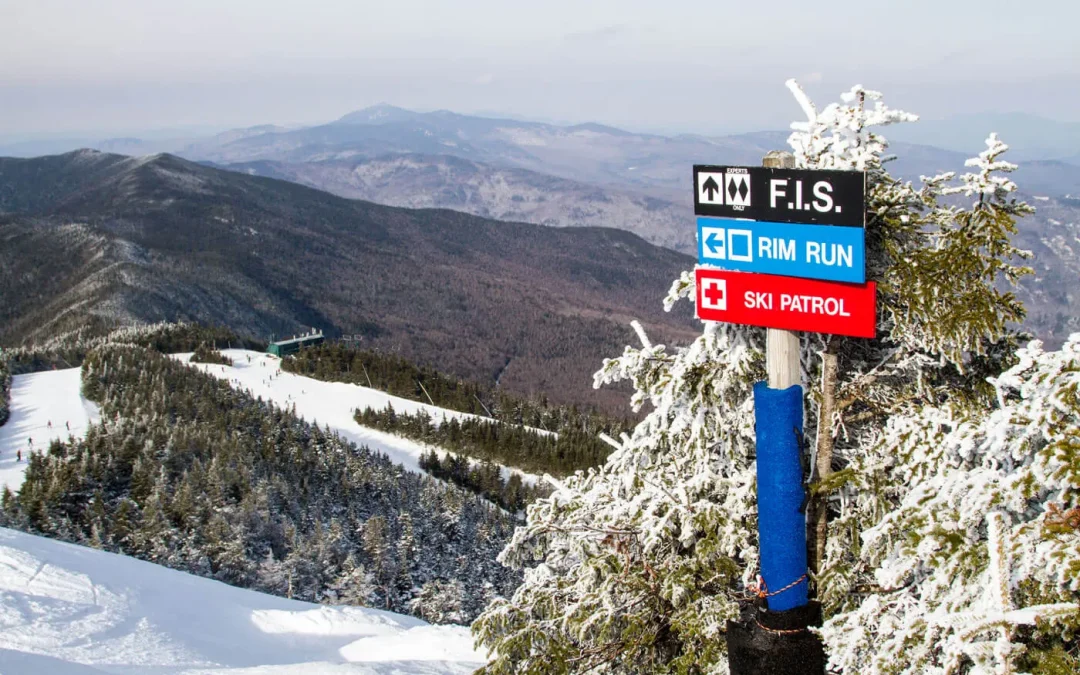In the majority of the world’s ski countries, the trail’s difficulty ratings are classified in colors. But in North America, Australia, and New Zealand, they combine colors with symbols.
It is very important to notice that those colors representing each type of run, are not the same in every country, as you can see in the image below: ski run levels

The system
It is not a standardized system, so an intermediate run in Europe could be (and usually is) more difficult than an intermediate in North America, for example. Ski trail levelsski run levels
1) Beginner runs: AKA “Bunny hills” or “Nursery slopes”, they are usually very wide, with a gentle slope. They are the easiest trails to ski. For advanced skiers, these runs are full of moving-human slalom poles to ski around (just kidding…). Actually, it is important to mention that advanced skiers should always try to avoid these beginner areas, and if not possible, slow down and ski them at low speed. The slope gradient goes from 6 to 25% (i.e. 3° a 15°) in these beginner areas.
2) Intermediate runs: They are popular trails at most resorts because they provide skiing that’s fun but not too challenging or scary. The slope gradient goes from 25 to 40% (i.e. 16° a 25°). ski run levels
3) Advanced runs: These trails can be steep, narrow, or ungroomed. The slope gradient is greater than 40% (i.e. >25°). In North and South America, France, Spain and Andorra there is one type more called “expert only”. A trail will be rated by its most difficult part, even if the rest of the trail is easy. Although slope gradient is the primary consideration in assigning a trail difficulty rating, other factors come into play:Ski trail levels
Besides steepness, the skiability of a slope depends on:
_snow conditions
_grooming
_width of the trail
_sharpest turns
Frequently, skiers and snowboarders will simply refer to a trail by their colors (e.g., “let’s go cruise that blue”).
Slope grade: Slope is a measure of change in elevation. A rise of 1 meter (3 feet) over a run of 1 meter (3 feet) yields a 100 percent slope or 45° of inclination. In Europe and the U.S. percentage, “grade” is the most commonly used figure for describing slopes (not degrees).
The steepest slope in Europe is Courchevel’s Grand Couloir (80% gradient), but it is not possible to groom it (snowcats can’t handle that amount of steepness); the steepest groomed track is the Harakiri in Mayrhofen, Austria, with a 78% gradient.
Snow grooming
Generally, a snow grooming machine has two large rubber and steel tracks that disperse the weight of the machine evenly across the snow surface and cut into the snow to assist with climbing. Mounted on the front is a multi-directional blade that cuts and levels the snow surface before driving over it. A power tiller on the rear churns the snow to an even consistency before a large, heavy comb then drags across the surface leaving a corduroy finish on the snow.
Fresh powder is the Holy Grail of skiing – but the next best thing is sweet smooth corduroy. Carving turns on a perfectly groomed trail is one of the best experiences on the hill. Thus the slang term “carvaholic” (a skier or snowboarder addicted to the sensation of carving).
The width of the tracks left on the snow by the snowcat with the tiller and flaps is 5.5 meters (18 feet), a very good corridor to train short turns.

Snow groomers can handle very steep gradients due to their low center of gravity and large contact area, but they can also be assisted by winches. Winch Snowcats are used to groom steep runs (>35° or >70%). Using cable lengths of up to 1,200 meters and a tractive force of up to 4.8 tonnes, winches can support the machines on steep slopes. The snow groomer is anchored to an available shackle and grooms the steep stretches on the rope.
Anyway, there’s a pretty common saying among seasoned skiers that goes: “If they can groom it, it isn’t steep”.
Snowcats / snow groomers / ratracs are machines that:
1) Pack/compact the snow for 2 purposes
_ make it easier to ski on for all levels of skiers.
_ make the snow more durable: making it last 3 times more than ungroomed snow.
2) Crush the top ice layer (make it easier to ski on for all levels of skiers) and mix old and
new snow (done by the tiller)
3) Flatten or moguls removal: done with the front blade, it’s planed so that the surface is
uniform.
4) Redistribute snow, build ramps, and halfpipes.
Major manufacturers are Pisten Bully (Germany), Prinoth (Italy), Tucker (OR, United States), and the discontinued Rolba AG Ratrac (Switzerland).
History of North American ski trail’s difficulty rating system: The Walt Disney Company was considering opening a ski resort and did studies and tests on which colors worked best. The company had even tested skier’s reactions to different geometric figures, concluding, for example, that the symbol for easy terrain should be a circle, perceived as soft; its color should be green, perceived as mellow.
They came up with the current green circle for easiest runs, a blue square for an intermediate, a black diamond for an advanced, and a double black diamond for expert. This system was adopted by the National Ski Area’s Association 3 years later in 1968 and has stuck ever since.
Other important signs on the slopes:
Crossed skis or a vertical planted snowboard: used above an injured person, it’s a trail accident sign to alert others and protect the victim.

Keep ripping some arcs!
If you find this piece of information useful to improve your skiing, please support this website and help us to keep it up and create more content! A small donation really means a lot to us... Thank you so much!





Recent Comments